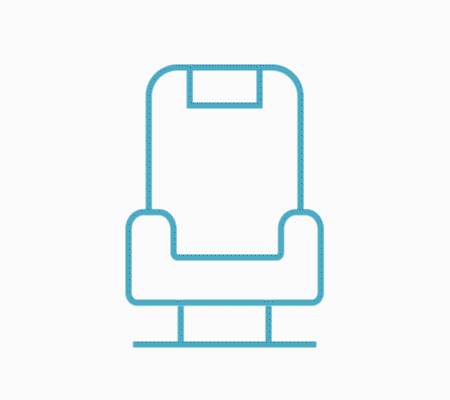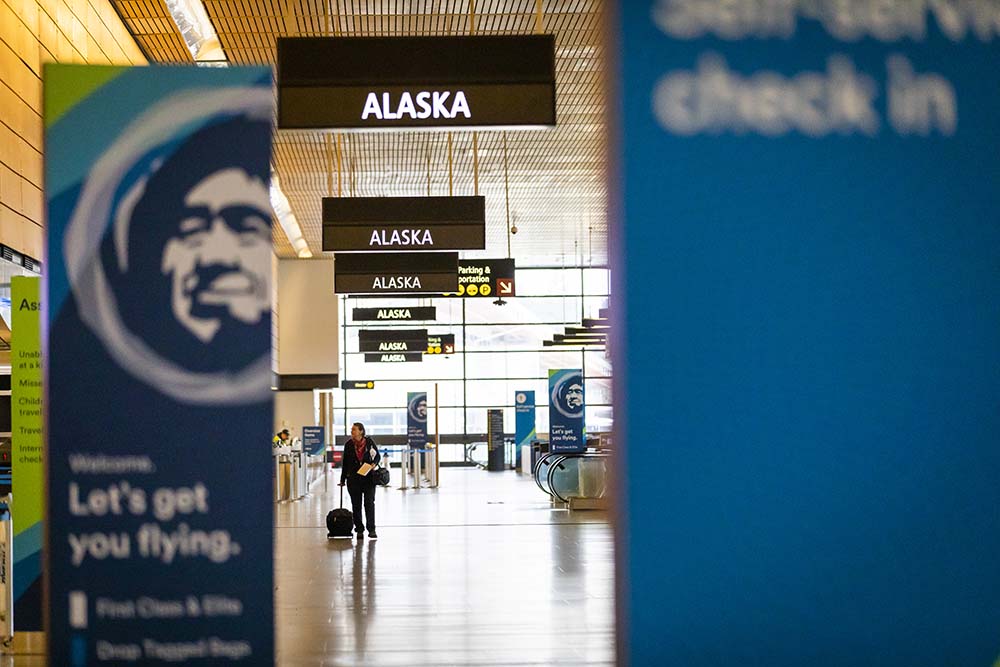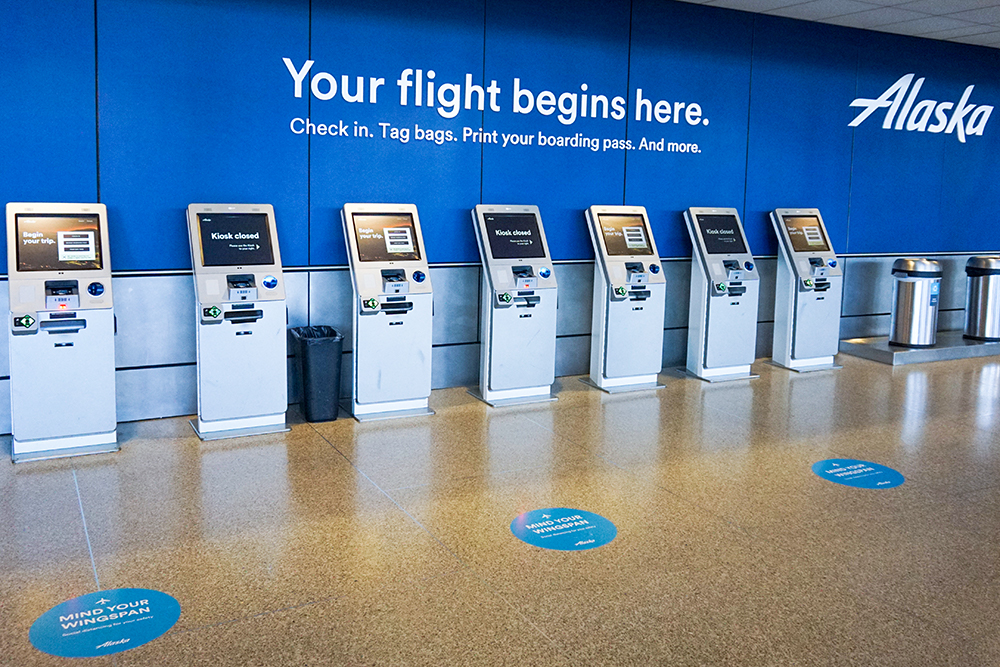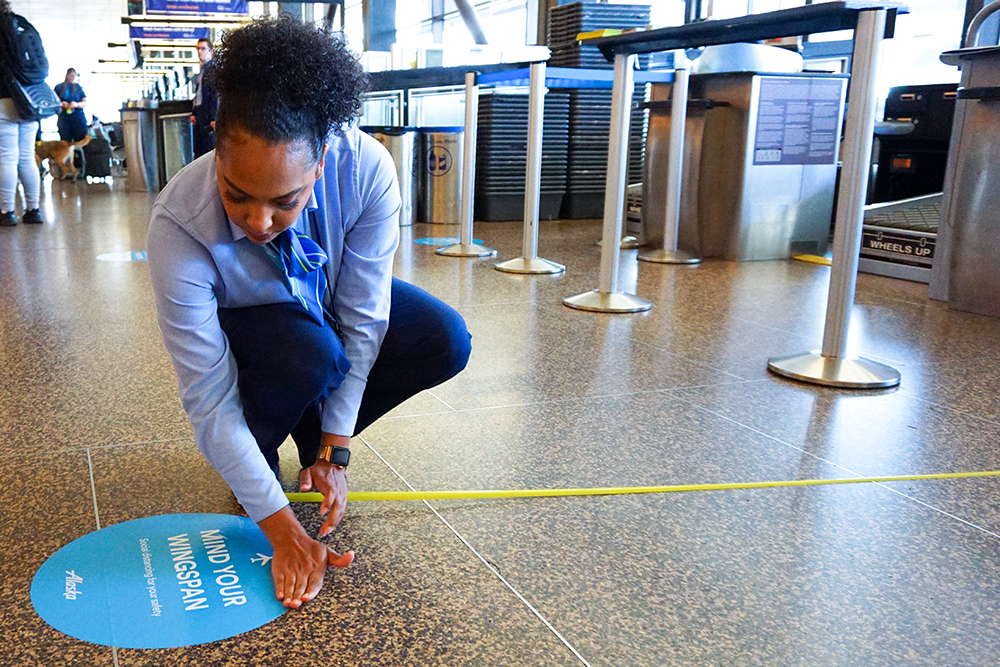Giving you the space and flexibility you need to mind your wingspan when flying Alaska
Share

Post updated August 5:

While health and government officials around the world continue to urge people to practice physical distancing, we know it can be challenging maintaining personal space on an aircraft. To help our guests, we’re taking additional precautions to help you create extra space on board, including:
- Through July 31, 2020 and beyond, we’re limiting the number of guests on our flights and blocking select seats. Families or large groups may request to sit together. Learn more here.
- Families or couples wanting to sit together can make the request with reservations in advance or at the airport on the day of travel.
- There can be limited occasions where extra space cannot be guaranteed due to unforeseen changes such as reaccommodating guests from a previously canceled flight.
- If you’re uncomfortable with the distance between you and others on your day of flight, please speak with a customer service agent about your options.
While this is a stressful time, it is important to remain calm and cooperate with airline staff. In a case where relocation may not be possible (due in part to aircraft weight and balance concerns), taking personal hygiene steps is also another way to help reduce your risk of contracting the virus.
Here are some other ways to ensure you’re keeping a safe distance when it comes to onboard service, crew interaction, boarding and more:
Before your flight

-
- Check or change your seat assignment through the Alaska Airlines app or online. Note: If you purchased a Saver fare, you may need to wait until your departure date to request a seat change.
- If we are unable to properly distance our guests on the aircraft, we will allow you to cancel or rebook your travel as part of our existing flexible travel options.
At the airport – mind your wingspan!

We’re installing social distancing decals to remind people to ‘Mind Your Wingspan,’ at each one of our airports where we fly. The stickers, spanning 6 feet apart, can be found at our ticketing counters, baggage drops, customer service centers and gate areas. The Alaska branded stickers will be deployed systemwide over the coming weeks.

-
- Ask a check-in or gate agent for the opportunity to move your seat. Our employees will make sure you are seated with as much distance as the flight allows. Note: If you purchased a Saver fare, you will be able to request a new seat when you arrive at the gate.
- On your way from the gate to the aircraft, we are doing our best to space out the boarding groups to limit crowding in the jetway.
Other safety measures to expect on board:
-
- To align with the Centers for Disease Control (CDC) recommendations and to keep our guests and employees safe, masks will be mandatory for all our guests. Additionally, Alaska Airlines and Horizon Air employees who cannot maintain six feet of physical distance during interactions with guests or co-workers are required to wear masks as of May 4. This includes pilots, flight attendants and customer service agents.
- Starting August 7, all Alaska passengers will be required to wear a cloth mask or face covering over their nose and mouth (except for children under the age of two) – with no exceptions. Cloth masks or face coverings will be required on all its flights, at ticket counters, throughout gate areas and any other location where Alaska conducts business.
- Guests will be expected to bring their own mask and will be required to wear it throughout the airport and flight experience. Additional supplies will be available for those who forget their face masks. Specific details about the face mask requirements will be shared with guests in pre-trip communications before their date of travel. The temporary policy will be reevaluated periodically as guidance evolves.
- We’ve updated our onboard service to limit the interaction between our flight crews and guests. Learn more.
- We’ve removed all seatback contents, except for the safety card to limit the spread of germs.
- We’ve enhanced our aircraft cleaning procedures between flights. Watch video.
- We’ve suspended our warm towel service in First Class.
- We’ve discontinued onboard sorting of recycling items to reduce touching guest-handled materials.
- We’ll continue to collect and recycle materials on Horizon Air’s simplified service of water.
- We’ve removed inflight entertainment tablets to make room for additional trash carts (except on flights to Hawaii and Florida).



 “This month is a very special time where we get the chance to share our culture with the rest of the world. Tonga is known for being the friendliest island and so I’d like to keep that spirit alive whether I’m at work, home or out running errands. Be a light wherever you go.” — Ila Langi, a customer service agent in San Jose California
“This month is a very special time where we get the chance to share our culture with the rest of the world. Tonga is known for being the friendliest island and so I’d like to keep that spirit alive whether I’m at work, home or out running errands. Be a light wherever you go.” — Ila Langi, a customer service agent in San Jose California “This month has become a little more meaningful to me than it has in the past because I have finally taken initiative the past couple months to expand more on what I know of my culture. Especially being married to my husband, who knows the language and culture almost so fluently, he has helped me so much. He’s so encouraging and he makes it so enjoyable to learn and love our culture!” — Angelica Mapa, a customer service agent in San Jose California “Every day, I always try to make it a habit to pass on my knowledge to the younger generation in my family by trying to speak as much Tongan in the home and teach them traditions that we still hold on to today. At work, I always try to answer questions about my culture and heritage to anyone that asks. I always admire my coworkers who openly share what traditional foods they love to make or traditional events they keep up with their family because it also encourages me to share mine as well. It’s always a safe place to share about our heritage at work because no one judges,” she said.
“This month has become a little more meaningful to me than it has in the past because I have finally taken initiative the past couple months to expand more on what I know of my culture. Especially being married to my husband, who knows the language and culture almost so fluently, he has helped me so much. He’s so encouraging and he makes it so enjoyable to learn and love our culture!” — Angelica Mapa, a customer service agent in San Jose California “Every day, I always try to make it a habit to pass on my knowledge to the younger generation in my family by trying to speak as much Tongan in the home and teach them traditions that we still hold on to today. At work, I always try to answer questions about my culture and heritage to anyone that asks. I always admire my coworkers who openly share what traditional foods they love to make or traditional events they keep up with their family because it also encourages me to share mine as well. It’s always a safe place to share about our heritage at work because no one judges,” she said. “This month means so much to me because not only does API month highlight my culture, it allows me to honor the generations before me that have paved the way for me, by their sacrifices and hard work. I am so blessed to have grown up in a multilingual household, and speaking multiple languages helps me stay connected to my heritage.” — Daniel Remigio, Seattle-based flight attendant
“This month means so much to me because not only does API month highlight my culture, it allows me to honor the generations before me that have paved the way for me, by their sacrifices and hard work. I am so blessed to have grown up in a multilingual household, and speaking multiple languages helps me stay connected to my heritage.” — Daniel Remigio, Seattle-based flight attendant “When most people think of Polynesians, they usually think of song and dance, and rightfully so, as it is the root of our culture. Dating back thousands of years, singing and dancing has been an ancient tradition used to communicate and connect, from ceremonial rituals to preparing for war to reciting history through storytelling and more. And although hula might be one of the first types of dance that comes to mind, there are actually many forms of ancient melodic traditions from around the South Pacific, like Samoa, Tonga, New Zealand, Fiji and Tahiti. But no matter which island or country, we all share that same heartbeat of Polynesia through dance.” — Shanyn Wright, multimedia communications specialist
“When most people think of Polynesians, they usually think of song and dance, and rightfully so, as it is the root of our culture. Dating back thousands of years, singing and dancing has been an ancient tradition used to communicate and connect, from ceremonial rituals to preparing for war to reciting history through storytelling and more. And although hula might be one of the first types of dance that comes to mind, there are actually many forms of ancient melodic traditions from around the South Pacific, like Samoa, Tonga, New Zealand, Fiji and Tahiti. But no matter which island or country, we all share that same heartbeat of Polynesia through dance.” — Shanyn Wright, multimedia communications specialist










 Not only can living herbs bring out so many flavors, but they can also be used as disinfectants and natural remedies for health and wellness. Pair sage with water with a little alcohol to make your very own natural disinfectant that smells wonderful, says Buehler.
Not only can living herbs bring out so many flavors, but they can also be used as disinfectants and natural remedies for health and wellness. Pair sage with water with a little alcohol to make your very own natural disinfectant that smells wonderful, says Buehler.

































 Those who complete the challenge by May 30 will receive a completion badge and congratulations from Strava with a link to a page on alaskaair.com to register for the drawing. Participants must register by June 7 to be entered to win the miles.
Those who complete the challenge by May 30 will receive a completion badge and congratulations from Strava with a link to a page on alaskaair.com to register for the drawing. Participants must register by June 7 to be entered to win the miles.